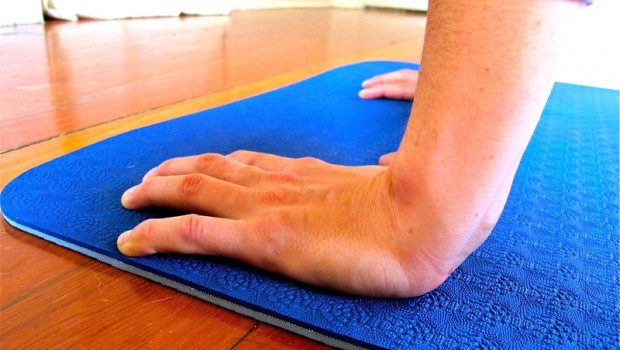A fairly common complaint in today’s age of computers and repetitive movements is wrist pain. Whether it’s a case of diagnosed Carpal Tunnel Syndrome or simply an overexertion injury, it impacts not only your yoga practice, but your daily life!
One of the struggles I observe in my yoga students who are dealing with injury limitations is the internal conflict that arises when I give them modifications of what the rest of the class is doing. I often notice a reluctance to do something different, especially what may seem like “less” than a full pose. But we must honor our body and accept the way things are right now, in this present moment, instead of struggling with how we’d like our body to be feeling or functioning. This acceptance may help you find the most appropriate external form of the pose, which will enable you to heal your injury and continue to practice regularly.
The key to protecting your wrists is—surprise!—a strong core. Evidence-based medicine demonstrates that a strong core can increase the efficiency of the rotator cuff muscles. These muscles stabilize the shoulders and can thus decrease the load that is transferred to your wrists. On the flip side, low core strength or failure to engage the core can lead to decreased trunk and shoulder stability. If the core is weak, strong forces transfer across the wrist, especially during transitions between poses. Think about the High Plank-Low Plank-Up Dog-Down Dog sequence. Each time you repeat it, your wrists bear weight throughout. Over time and without proper support, this can lead to injury. But when effort is dispersed throughout the core and shoulders in a vinyasa-based practice, that force in the wrists is minimized.
If you are struggling with wrist pain, it is ok to dial back your practice if it seems to be irritating your pain. During this time, Standing poses are particularly helpful in improving range of motion at the shoulder and arms, improving overall posture and strengthening and moving the head and neck around. The Warrior poses are also particularly helpful.
And when you are ready, reintroduce weight bearing on your arms slowly. Rather than launching into dozens of Sun Salutations, start by spending a little time almost every day on your hands and knees. In this position, there is relatively little weight on the hands, so the wrists can become accustomed to weight bearing.
On hands and knees, you can also vary the degree of extension of your wrists. If placing the heels of your hands directly below your shoulders feels too intense, you can move your hands out a little in front of your shoulders, reducing the amount of extension.
It is ok to dial back your practice, and to honor your wrists by allowing them to heal and strengthen gradually. This will allow for a smart return to your previous practice.
